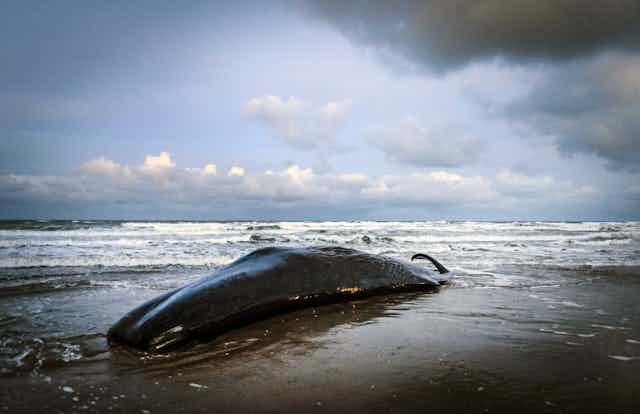A series of sperm whale strandings saw 29 of the animals beached across the North Sea in early 2016. As these whales are not normally found in the North Sea, the strandings were a bit of a mystery. But a study is now proposing that the solar storms that cause the northern and southern lights (aurora) could be to blame for the ill-fated whales ending up on the beaches.
In their seasonal migrations between warmer equatorial waters and the squid-rich Norwegian Sea, sperm whales generally don’t travel through the North Sea. Instead, they migrate along the western coast of the British Isles. The North Sea is far too shallow for the whales and their favourite squid prey (Gonatus fabricii) generally isn’t found there either.

So once the whales entered the North Sea, it’s likely that they became disorientated, trapped in the shallow waters and ultimately beached. Necropsies performed on the whales suggested that they were healthy and well nourished, and so why they had entered the North Sea at all was a mystery.
It is thought that some animals can get a sense of direction from the Earth’s magnetic field. Indeed, cetaceans, which includes whales and dolphins, are thought to be able to navigate using “magnetoreception” just like migrating birds and bats. The recent study suggests that the whales’ detour into the North Sea was the result of a geomagnetic storm interfering with the whales’ magnetic navigation system.
The authors propose that these storms, which are the result of explosions of particles from the sun, created disturbances in the Earth’s magnetic field. They specifically identify two geomagnetic storms – occurring on December 20/21, 2015, and December 31 and January 1, 2015/2016 – which they argue could have caused disturbances strong enough to confuse the whales into travelling down the east coast of Shetland, rather than the west.

They suggest that a series of magnetic mountains, which have a magnetic field that is stronger than the surrounding area, would normally act as a barrier to the whales – preventing them from straying into the North Sea. During the storms, however, the local magnetic field was altered so much that these magnetic mountains appeared invisible to the whales – allowing them to pass into the North Sea.
Powerful impact
The idea that geomagnetic storms cause navigational issues for animals is somewhat new but previous studies have shown that homing pigeons and migrating birds, for example, have trouble navigating through regions of magnetic anomalies. One study has found that the number of honey bees returning to their hive seems to drop significantly during geomagnetic storms, though the exact link remains unknown.

We have known for a long time that the sun’s activity, and the space weather it produces, can have a significant impact on us here on Earth. Not only does space weather produce the beautiful aurora that lights up the night sky, it can also cause serious damage to our technical systems.
In fact, space weather has already resulted in damage to satellites, interference with the Global Positioning System (GPS) and power grid failure. And it is estimated that a serious space weather event could cost the global economy US$40 billion per day.
Finding proof
While there’s increasing evidence that space weather can also affect biological organisms, it’s important to remember that a correlation is not the same as proof.
Further scientific analyses, such as actually monitoring a large number of whales to see if, and how, their travel paths change during geomagnetic storms, will be needed to prove this link for sure. After all, geomagnetic storms happen fairly often, so it could simply be a coincidence that these two events happened around the same time.
While space weather scientists are working hard to prepare our technological systems for future space weather events, it seems as though we may have to let nature take its course for the whales – at least for now.

